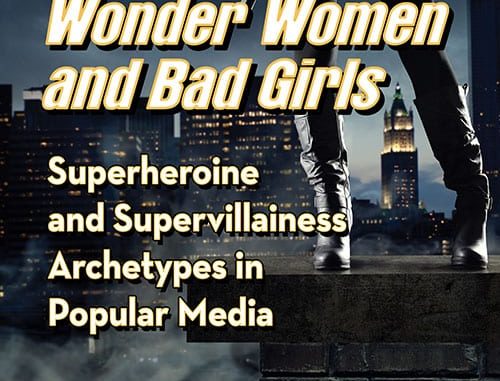
Review Fix chats with “Superheroines and the Epic Journey and Wonder Women and Bad Girls†author Valerie Estelle Frankel, who discusses the book and so much more.
About the Book:
Wonder Woman, Harley Quinn, Shuri, and Black Widow. These four characters portray very different versions of women: the superheroine, the abuse victim, the fourth wave princess, and the spy, respectively. In this in-depth analysis of female characters in superhero media, the author begins by identifying ten eras of superhero media defined by the way they portray women. Following this, the various archetypes of superheroines are classified into four categories: boundary crossers, good girls, outcasts, and those that reclaim power. From Golden Age comics through today’s hottest films, heroines have been surprisingly assertive, diverse, and remarkable in this celebration of all the archetypes.
About the Author:
Valerie Estelle Frankel teaches English at Mission College and San Jose City College. The author of 75 popular culture books and more than 100 stories and essays, she lives in Sunnyvale, California.
Review Fix: What inspired this book?
Valerie Estelle Frankel: Superheroines and the Epic Journey and Wonder Women and Bad Girls are actually a set: Joseph Campbell’s The Hero with a Thousand Faces is half story arc and half archetypes. I followed this pattern with my first heroine’s journey guide, From Girl to Goddess, and, with all the new superheroine films and TV and novels, I wanted to explore the specifics of the heroine’s journey for the superheroine and how her archetypes work. But there are so many superheroines, the archetypes got their own book.
Review Fix: What was your research process like?
Frankel: Watching stuff! Sometimes the entire show, sometimes just an episode for a particular guest star or arc, like significant Black Canary episodes on Arrow. And reading so many comics. I think I’ve read every superheroine comic out there. Nonfiction analysis of them too of course. And there’s a surprising number of novels and short stories.
Review Fix: What’s your favorite part of the book?
Frankel: Celebrating the subtle differences–like, superheroines go on the classic heroine’s journey, but the costume and self-naming are unique additions. Not to mention the discovery of superpowers and what they represent about adulthood. Their shadow and persona are reversed, with a Diana Prince side masking the colorful heroine. There’s a lot going on. The archetypes book likewise looks at, for instance, what makes a super seductress different and what themes the stories are pushing. How have comics done the super-crone? The mystic? The trans superheroine?
Review Fix: What other important concepts does your book explore?
Frankel: When I started, I divided the characters into good girls and bad girls, but that’s not wholly accurate…many superheroines condemned by society are closer to victims, like Harley Quinn or Katana or Karma. And then how each author chooses to address that problem. That was interesting.
Review Fix: Any challenges?
Frankel: Just the obvious of so much material coming out. Even the forties comics are being reprinted and are increasingly easy to find.
Review Fix: What makes female superheroes cooler than male?
Frankel: As the Wonder Woman and Captain Marvel films showed (to say nothing of Agent Carter!), they have to battle societal assumptions that they can’t do the job. To say nothing of men leering at them, judging their outfits, and telling them to smile. That’s extra baggage when they have all the same superhero work to do.
Review Fix: Why do we love a strong female hero?
Frankel: That in itself prompts the question, “Does she have any other traits?” There are some great articles out there on how having a character with no personality but strength is kinda painful. You can see this in some of the tough silent types in X-Men: Apocalypse, for instance.
Review Fix: Most underrated female villain?
Frankel: Talia al Ghul. She’s interesting and has a lot going on, but writers often deprive her of agency and give her bit parts. Her storytelling is very inconsistent.
Review Fix: What did you learn that you weren’t expecting?
Frankel: When I started research, I assumed diversity really kicked off in the seventies with the new X-Men under Chris Claremont. That certainly happened, but superheroines were astoundingly diverse and competent in the forties. The Girl Commandos fought in World War II, Senorita Rio spied for America, Nelvana of Northern Lights was a half-Inuit superheroine in Canada. Only when the men returned did the superheroines shrink down.
Review Fix: How do you want the book to be remembered?
Frankel: Wonder Women and Bad Girls shows the spectrum of superheroines and all the cool roles they’ve found. Superheroines and the Epic Journey shows how we write the story of the epic heroine.
Review Fix: Why should a Comic book fan read this?
Frankel: Both books are filled with fun explorations of their favorite heroines…and I cover so many that there’s a good chance I featured yours. Plus more you didn’t know about that you’d love. Hardcore fans of each franchise enjoy all the stuff they learn from my deep analysis of symbolism and depth psychology.
Review Fix: What’s next?
Frankel: The Villain’s Journey (surprisingly something no one’s done, and there’s been a big boom in villain stories lately) is out this fall.


Leave a Reply